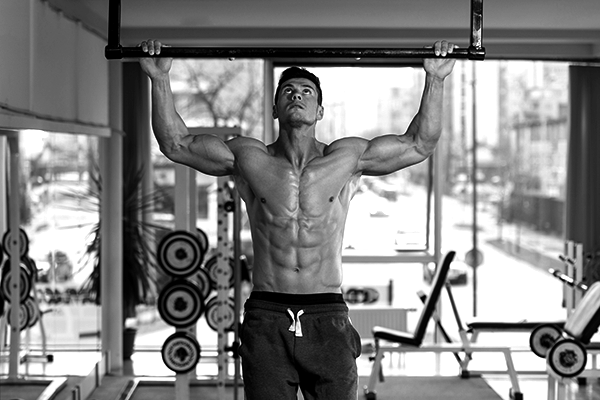
The biggest leaps always yield the greatest results - and with this usually comes the greatest risk. Pull-ups are one exercise to which this mantra certainly applies. When used correctly, pull-ups can deliver great gains in terms of back strength, muscle mass, definition, and overall development. However, if they are done incorrectly, the results are the opposite. You'll see wasted time and effort at best, and serious injury at worst. You can look at pull-ups as a very fast, high-performance sports car. When driven correctly, you are the baddest ride on the road. When used improperly, you stall out at best, and find yourself spun out in a ditch at worst. Let's look at some ways you can improve your current pull-up performance.
Control
The most common error made by lifters using pull-ups usually involves control. Let's face it, the body is hanging from the bar, and not exactly in its strongest position. There is a natural inclination to swing the body, to make the movement easier and because simple physics pull the body into motion no matter what you do, anyway. The wise lifter will consciously fight any swinging motion by the body, keeping the torso and hips as flexed and stationary as possible why the arms pull the body up with each repetition. If you have any doubt about your performance, try filming your repetitions using your cell phone. If it's obvious you cannot control your body no matter what, you can use a spotter. Someone holding your torso in place will keep that swing away, and keep your lat and core muscles doing the work, as they are designed to do. Also, you will want to bring down that…

Speed!
Yes, when it comes to painful exercises which test our patience and make us look almost mortal, many of us will move through the exercise a little bit quicker than we should, Doing so lets us knock out an extra rep or so each set, but also deactivates many of the muscle fibers we could otherwise be recruiting to move our bodies through slow and precise repetitions. Exposing our vulnerabilities isn't exactly our strong suit, is it?
In this case, however, doing so is fine. Nobody really cares if you struggle with pulling your 220 pounds of muscle to the bar, if you are growing your monster lat muscles as a result of each week's workout. Count to 3 on the positive on each repetition, and 3 on the way down. Make each repetition as slow and as painful as possible, as every ounce of pain is accompanied by the firing of new batches of muscle fibers. That is, as long as you are in the correct…
Position?
Yes, that is correct. If your body is out of position, then you are going to transfer the bulk of the workload away from the lat muscles of the back you are targeting. Instead, the hips, shoulders, biceps, joints and tendons of your body will end up moving your body through the motion with each pull-up. That is, of course, a monster waste of time!
When completing pull-ups, the body is out of position when the hands are too far outward, or too close to one another. This may allow the rep to be "easier", but that is a loose definition. Most wise lifters consider building an amazing back in only 3 to 6 months through proper form to be way easier than wasting a decade cheating the reps, and cheating yourself in the process. You also may be making the classic rookie mistake of placing your hands in the UNDER-hand position. This is fine for completing biceps CHIN-ups on arm day. Doing so on back day will merely wear out your arms prematurely and leave your back under-trained. Speaking of undertraining, what are you FEELING when you train? Cause it's all about that…

Flexion
You aren't a powerlifter. You aren't rewarded by how many pounds of body weight you move with each pull-up workout. Rather, your payday arrives when you take off your shirt, at the beach, or the bodybuilding/physique stage, and you have a back that casts a shadow upon every hater and competitor around you! Your back will look its best if you stimulate all back fibers. You don't do this by competing pull-ups. Rather specifically, you stimulate the ultimate number of back muscle fibers when you flex the back muscles throughout the duration of each repetition of every workout. This activates the muscle fibers. They take a beating as a result, but thanks to your proper diet, they rebuild in the following days and come back stronger. Before you know it, you're TOO strong to benefit any longer from the use of body weight pull-ups. It's just about this time that you realize you need to add…
Resistance!
Yes, the final factor to address when it comes to building the perfect pull-up is resistance. Once you can knock out 12 to 15 perfect pull-ups without assistance using your body weight, it's time to add more weight! No, you shouldn't hit the buffet and add the weight to your waistline. Rather, you should put on a weight belt, wrap a chain around it, and clip a 5 pound plate to your body. Your lats will now be moving 225 pounds instead of your usual 220 pound body weight. Once you can knock out 12 reps, move up to a 10 pound plate. Try to increase by 10 pounds each month, keeping the repetitions slow and controlled.
Proper pull-up performance comes down to a few things… speed, position, control, flexion, and resistance. Missing any one of these factors can render this movement ineffective. Miss any two factors, and you're likely to end up facing down an injury. Train smart, using the ultimate control. Remember that lifting using pull-ups is just as much a mental game as it is a physical performance. Good luck!


